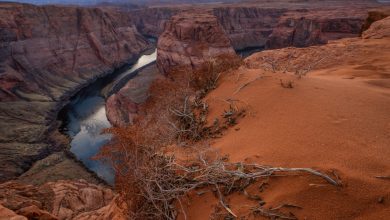News
All the newsClimate change: will the Colorado soon dry up?
 A river that no longer reaches the sea: this is already frequently the case of the Colorado, which flows into the Gulf of California. And every additional degree will exacerbate the drought affecting this huge river, 2,330 km in length, that supplies water to seven American states. A study published in the journal Science in mid-February revealed that its discharge had fallen by 20% in one century, mostly due to climate change and more frequent droughts.
A river that no longer reaches the sea: this is already frequently the case of the Colorado, which flows into the Gulf of California. And every additional degree will exacerbate the drought affecting this huge river, 2,330 km in length, that supplies water to seven American states. A study published in the journal Science in mid-February revealed that its discharge had fallen by 20% in one century, mostly due to climate change and more frequent droughts.
Long-term data to better predict the future
Two researchers from the United States Geological Survey (USGS) modelled the movement of water (snow, rain, evaporation, river discharge, etc.) in the whole of the upper basin of the river from 1913 to 2017, using rainfall and temperature records, and satellite observations, to understand the effect of climate change on these movements.
They observed that the increase in air temperature led to a reduction of accumulations of snow and ice from one winter to another. Less snow means that it melts earlier in the spring every year. A surface area covered with less snow reflects less sunlight, and thus more rays are absorbed by the watershed instead of being reflected back into space. This additional absorbed energy causes the evaporation of more water, leading to a reduction in the river’s discharge. According to the researchers, the reduction of the annual discharge by evapotranspiration amounts to 9.3% per degree Celsius of heat!
 Variations in rainfall also impact the discharge, leading to fears of greater risks of serious water shortages in the future. By combining their simulations with climate models, the two American researchers estimated that Colorado’s discharge could fall even further, from 14 to 31% by 2050, in comparison to the average annual discharge of the last century.
Variations in rainfall also impact the discharge, leading to fears of greater risks of serious water shortages in the future. By combining their simulations with climate models, the two American researchers estimated that Colorado’s discharge could fall even further, from 14 to 31% by 2050, in comparison to the average annual discharge of the last century.
The river’s equilibrium threatened
The impacts of climate change not only threaten the river’s ecosystem but also the regional economy. Indeed, the River Colorado plays a key role in supplying the largest artificial freshwater lake in the United States. The system of dams, including the famous Hoover Dam and reservoir lakes, supplies more than 40 million inhabitants with water, from Denver to Phoenix and Las Vegas, and thousands of km2 of irrigated farmland in this extremely arid region of the southwest US. 16 million jobs depend solely on the river.
 The basin’s hydrographic system is already under pressure: the two large reservoirs of Lake Powell and Lake Mead are half empty and the delta is weakened by erosion and the influx of salt water. Excessive withdrawals of water combined with climate change are jeopardising the very future of the river (cf. previous article “Southwest America : the Colorado river runs dry”)
The basin’s hydrographic system is already under pressure: the two large reservoirs of Lake Powell and Lake Mead are half empty and the delta is weakened by erosion and the influx of salt water. Excessive withdrawals of water combined with climate change are jeopardising the very future of the river (cf. previous article “Southwest America : the Colorado river runs dry”)
In May 2019, the representatives of 7 States of the Colorado basin and the Federal Government took stock of the problem by signing a Drought Contingency Plan for the upper and lower watersheds of the river. The aim is to reduce risks and protect the largest water resource in the west of the United States. This agreement also relies on concerted actions with the Amerindian tribes and Mexico.
It remains to be seen whether it will be enough in the long term…